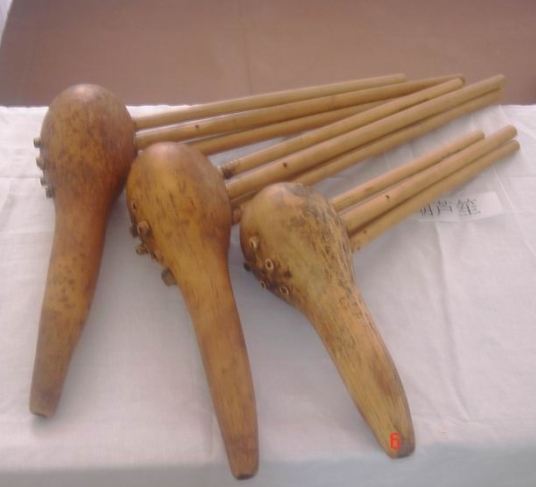History and Development of Hulusheng
Sheng, with a long history, originated in the Central Plains and was later introduced to the southwestern minority areas. As early as in the Shang and Zhou dynasties, there was a kind of musical instrument made of gourds in the octave classification of ancient Chinese musical instruments, the sheng. Several shengs from the early Warring States period unearthed from the tomb of Zenghou Yi, Suixian County, Hubei Province, fully proved this point.

The gourd Sheng used by ethnic minorities in Southwest my country also has a relatively long history and is improved from the Sheng introduced from the Central Plains. From 1955 to 1960, in Shizhai Mountain, Jinning County, Kunming City, Yunnan Province, ancient tombs were excavated that were used by nobles led by the King of Dian for a long time. In 1972, in the pre-Qin ancient tomb excavated in Lijiashan, Jiangchuan County, Yuxi Region, Yunnan Province, two more bronze gourd-sheng buckets were unearthed, with a height of 28.2 cm and 26 cm, respectively. Seven holes and five holes can be inserted into the corresponding pipe, and the thin end of the curved pipe is cast with a standing bull, which is beautiful in appearance and vivid in image. In addition, a bronze gourd shengdou was also unearthed in the tomb of Dabona Mukuo, Xiangyun County, Dali Bai Autonomous Prefecture, Yunnan Province. It shows that the gourd Sheng has been spread in the vast area of southwest my country in the pre-Qin and Han dynasties.
Tang Dynasty
In the Tang Dynasty, among the ethnic minorities living in Nanzhao (now Dali, Yunnan), the gourd or gourd was quite popular. Young people often used the gourd to blow beautiful tunes in the streets and alleys to convey love to their beloved girls. When talking about the customs of Nanzhao, Fan Chuo's "Man Shu" in the Tang Dynasty said: "Young children marching through Luxiang in the evening, blowing pots and lusheng or blowing leaves, in the rhythm, they all send love words and call with pictures." The Book of Tang, Nanzhao Biography (Volume 222) contains: "Blow the gourd and four pipes. When the wine arrives in front of the guests, push the cup to persuade the wine." An interesting scene in which the gourd Sheng pushes the wine glass and persuades the guests to drink. Ancient Nanzhao folk music was popular, and in 800 AD, "Fengsheng Music" was presented to the Tang Dynasty. In Duan Anjie's "Yuefu Miscellaneous Lu" in the Tang Dynasty: "In Kaiyuan, there are clappers... gourd Sheng." It is also mentioned that in the middle years of Tang Xuanzong (AD 847-859), "Yibu music... There are pots." Lusheng".
Northern Song Dynasty
During the Northern Song Dynasty, when the ethnic minorities in the southwest went to the Song capital to pay tribute, they also brought calabashes to Bianliang (now Kaifeng) in the capital. "Song History" has: "In the first year of Zhidao (AD 995), the king of Longhan, sent his envoy Long Guangjin, and led the barbarians in the southwest (today's eastern Yunnan and western Guizhou) to pay tribute to the objects... To sing and dance in the country. One person blows the scoop, like the sound of mosquitoes and gnats; for a long time, dozens of generations turn around and dance, with the foot on the ground as a festival, and when you ask for the song, it is called "Water Song"." According to this record, a small number of Chinese The national "Hulu Sheng Dance" also has a history of 1,000 years. In the fourth year of Shaosheng in the Northern Song Dynasty (AD 1097), 62-year-old Su Dongpo was banished to Hainan and lived in Danzhou. In his poem "Dan'er", he used vivid and refined words to describe the folk singing and dancing activities of the Li people in Hainan. , in the poem "Hejiugu": "I have a visit to the mushroom chicken bou. Bronze drum pot Lusheng, sing this to send the poem", and there is a note at the end of the sentence: "Hand over? Cut it into a sheng." It can be seen that this poem is realistic, indicating that there was also a gourd sheng in the Northern Song Dynasty in the Li nationality area of Hainan Province.
Southern Song Dynasty
In the Southern Song Dynasty Fan Chengda's "Guihai Yuheng Zhi", there is a sentence: "Hulusheng, Liangjiangdong Zhongle". In the Southern Song Dynasty, Zhou Qufei wrote in his "Answering Outside the Mountains" (Volume 7): "The joys of the Yao people include lusha, drums, gourd sheng, and bamboo flute." It's humbling." Zhu Fu of Song Dynasty wrote in "Xi Man Cong Laughing": "The gourd sheng is arrogantly blowing, but it is also a little bit more, but the six-pipe gourd sheng is listed in the article and now is the six-pipe gourd sheng of the Yi people in Chuxiong, Yunnan. Exactly the same. Since the Tang and Song Dynasties, many documents have recorded that the gourd Sheng was popular in the areas where the Miao, Yao, Bai, Li and other ethnic groups lived together. Although some ethnic groups no longer use it today, it was mainly based on the gourd Sheng in ancient times. It was still used in the Qing Dynasty. For example, in the "Tong Dian of the Qing Dynasty" (Volume 64): "Hunan Miao beat bronze drums and sand gongs to worship ghosts and gods. At relatives banquets, sang and bronze drums were fun." Today, gourd sheng is in our country. It is very popular among many ethnic groups in the southwest, especially the Yi, Lahu, Wa, Lisu and other ethnic groups.
 渝公网安备 50010702504639号
渝公网安备 50010702504639号